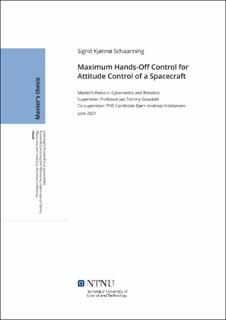| dc.contributor.advisor | Gravdahl, Jan Tommy | |
| dc.contributor.advisor | Kristiansen, Bjørn Andreas | |
| dc.contributor.author | Schaanning, Sigrid Kjønnø | |
| dc.date.accessioned | 2021-09-23T19:04:20Z | |
| dc.date.available | 2021-09-23T19:04:20Z | |
| dc.date.issued | 2021 | |
| dc.identifier | no.ntnu:inspera:76427839:45142030 | |
| dc.identifier.uri | https://hdl.handle.net/11250/2781098 | |
| dc.description.abstract | Denne avhandlingen utforsker bruken av "maximum hands-off" regulering for attituderegulering av en satellitt som er drevet av reaksjonshjul. Maximum hands-off, eller den L0-optimale, regulatoren forsøker å finne pådragssignalet som er mest "sparse" blant alle mulige pådragssignal. L0-optimale problemer er generelt vanskelige å løse siden en kostfunksjon basert på L0-normen hverken er kontinuerlig eller konveks. Tidligere forskning har undersøkt metoder for å tilnærme L0-normen, for eksempel ved bruk av en L1-norm. Denne oppgaven foreslår å bruke en L0-kostfunksjon med komplementære begrensninger som en tilnærming til maximum hands-off problemet for attituderegulering av en satellitt. Deretter brukes maximum hands-off regulatoren for å løse attitudereguleringproblemet for en satellitt, og pådragssignalet fra maximum hands-off regulatoren sammenlignes med pådragssignalet fra den L1-optimale regulatoren. Denne oppgaven viser at maximum hands-off regulatoren er mer sparse enn den L1-optimale regulatoren for et av problemene som ble undersøkt gjennom simuleringer basert på en 6U CubeSat. Simuleringene ble gjennomført ved bruk av optimeringsverktøyet CasADi, og L1- og L0-optimeringsproblemene ble diskretisert ved bruk av "direct multiple-shooting" og løst ved bruk av IPOPT. I tillegg til disse resultatene så foreslår denne oppgaven en ny type regulator, kalt "moving maximum hands-off" regulator, som lar brukeren spesifisere i hvilke tidsintervaller pådragene skal settes på og prøver å finne pådragssignalet som er mest sparse blant alle gyldige pådragssignaler, basert på denne informasjonen. Det viste seg at moving maximum hands-off regulatoren er like sparse som maximum hands-off regulatoren for noen satellittmanøvere. | |
| dc.description.abstract | This thesis explores the use of maximum hands-off control for attitude control of a spacecraft actuated by reaction wheels. The maximum hands-off, or L0-optimal, controller aims to find the sparsest control signal among all admissible control signals. However, L0-optimal problems are generally hard to solve as L0-cost functions are discontinuous and nonconvex. Previous research have investigated methods to approximate the L0-norm in the cost function, for instance, using an L1-norm. This thesis proposes an approach to the maximum hands-off control problem for spacecraft attitude control involving an L0-cost function relaxed through complementarity constraints. Then, the controller is applied to the spacecraft attitude control problem, and the sparsity of the maximum hands-off controller is compared to that of the L1-optimal controller. The maximum hands-off controller is shown to be sparser than the L1-optimal controller for one of the problems investigated through simulations based on a 6U CubeSat. The simulations were conducted using CasADi as the primary optimization tool, and the L1- and L0-optimal control problems were discretized using direct multiple-shooting and solved using the IPOPT solver. In addition to these results, this thesis proposes a new paradigm of control, called moving maximum hands-off control, which lets the user specify in which time interval the control should occur and aims to find the sparsest control among all admissible controls based on this information. The moving maximum hands-off controller is shown to be as sparse as the maximum hands-off controller for some spacecraft maneuvers. | |
| dc.language | eng | |
| dc.publisher | NTNU | |
| dc.title | Maximum Hands-Off Control for Attitude Control of a Spacecraft | |
| dc.type | Master thesis | |
